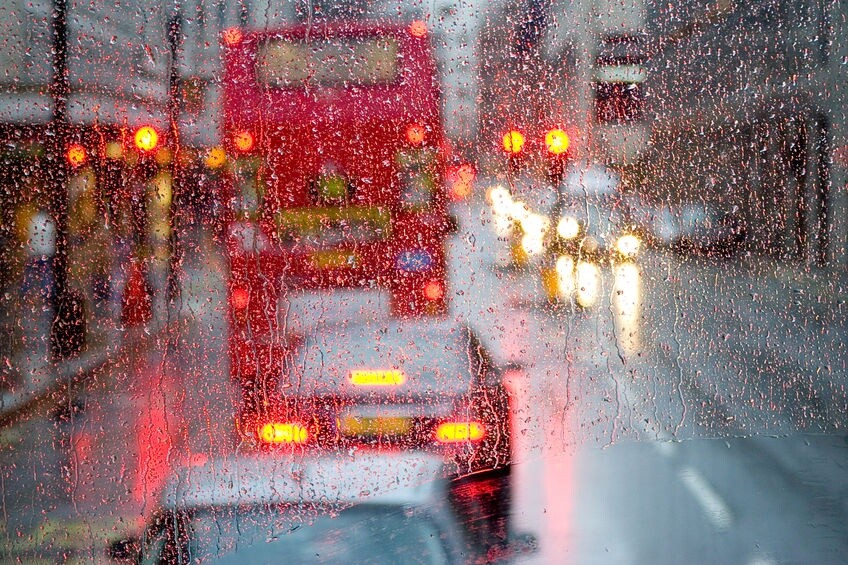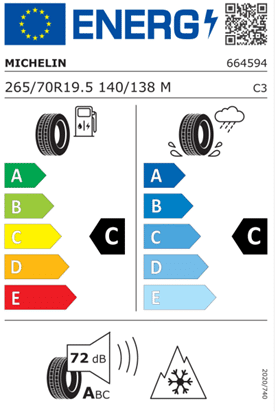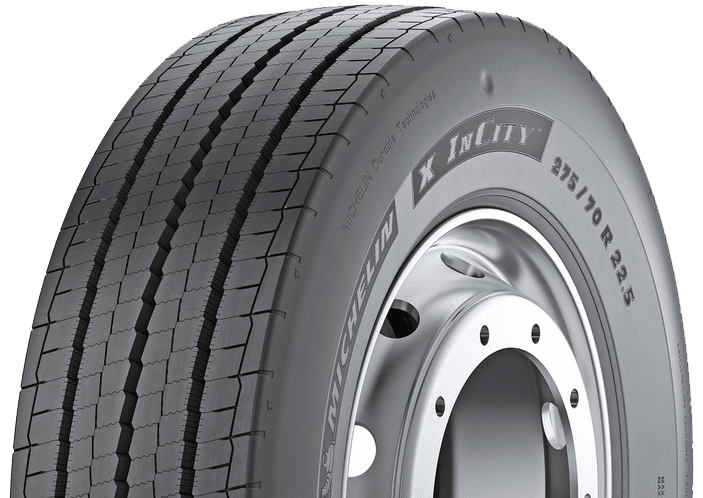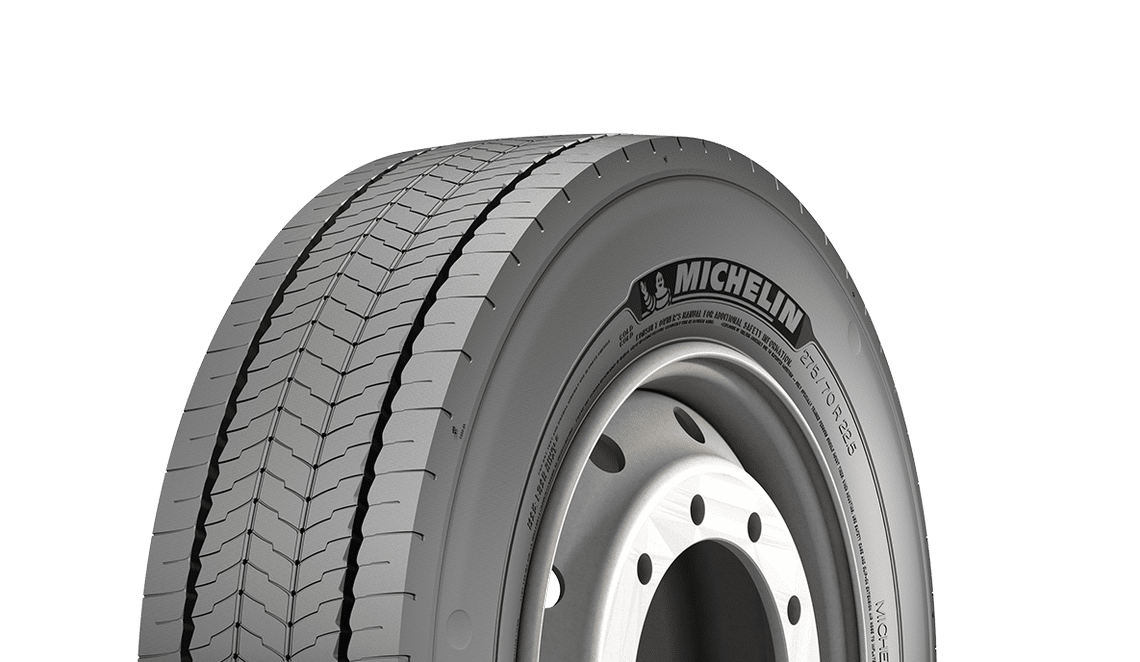
bus city
Yellow bus and cars on the main street of the city against the backdrop of modern houses in Riga in summer. Blurry
How to choose bus tyres for safety and comfort
Choosing the right bus tyres is a crucial aspect of ensuring passenger safety, comfort, and operational efficiency. Tyres play a fundamental role in how buses perform under various conditions, impacting safety, noise levels, and long-term costs. Discover the essential criteria for choosing bus tyres and the MICHELIN ranges that meet them in every aspect.
3 essential criteria for choosing bus tyres
1 - Reinforced sidewalls
One of the most critical aspects of bus tyre selection is ensuring that the tyres have reinforced sidewalls. This feature is essential due to the unique wear that bus tyres experience. They tend to suffer side damage, particularly from contact with kerbs at bus stops.
Sidewall wear, rather than tread wear, is often the primary cause for tyre replacement in buses. Therefore, choosing tyres with reinforced sidewalls helps reduce maintenance costs and ensures continuous safe operation. Bus tyres with reinforced sidewalls are designed with an extra layer of rubber that provides additional protection, thereby prolonging tyre life and enhancing safety.
2 - Wet grip and braking performance
Good wet grip is essential for bus tyres to ensure passenger safety, particularly in cities where emergency braking is frequent. Tyres with improved wet grip can significantly reduce braking distances on wet roads, which is essential for safe operations in variable weather conditions.
By choosing tyres that offer excellent grip on wet surfaces, you can not only prevent potential accidents but also contribute to passenger confidence in the transport service.

Bus and other vehicles - rainy day
London rain view to red bus through rain-specked window
3 - Noise reduction
With the rise of electric buses, noise reduction has become an increasingly important consideration. Electric buses produce less engine noise, making tyre noise more noticeable. As a result, choosing tyres that emit lower noise levels is crucial for maintaining passenger comfort and reducing noise pollution in urban areas
European labelling
The EU tyre label provides important information about three key performance aspects:
- fuel efficiency
- wet grip
- noise levels.
Tyres are graded from A to E for fuel efficiency and wet grip, A being the best. Noise levels are rated with an ABC scale, with additional decibel figures displayed.
While fuel efficiency is less impactful for buses compared to other vehicles because of the short distances covered in cities, wet grip, as we have pointed out, is crucial for safety. Tyres with higher wet grip ratings provide better braking performance, reducing the risk of accidents during sudden stops in urban areas.
As we said earlier, noise levels are important for maintaining passenger comfort and reducing urban noise pollution. Tyres with lower noise ratings contribute to a quieter ride, enhancing the overall experience for passengers and helping transport services comply with local noise regulations.

European labelling
Additionally, it is important to understand the significance of the 3PMSF (Three-Peak Mountain Snowflake) logo.
This logo indicates that the tyre has been tested and certified by an independent and certified laboratory for superior performance in severe snow conditions, ensuring that it can handle winter weather safely.
This is particularly beneficial for bus operations in regions that experience harsh winter climates.

The 3PMSF logo
Optimisation and maintenance
While choosing the right tyres for your buses is essential, so is their maintenance. In this context, practices are beneficial to extend tyre life and maintain performance. For example, a good practice is to rotate tyres by moving the worn sidewall from the outside to the inside. This optimises tyre use and reduces the frequency of replacement.
Additionally, reinforced tyres often come with sidewall wear indicators (small markers that show when the tyre needs to be replaced or rotated). Keeping an eye on these indicators helps to avoid unexpected tyre failures and maintain high safety standards.
Another effective maintenance measure is retreading, which involves replacing the worn tread of a tyre with a new one. If the tyre is retreadable, this is an asset for your bus fleets, as you can reduce not only your operating costs but also your environmental footprint by making the tyre last longer.
Recommended bus tyres
The MICHELIN X® INCITY XZU tyre for urban bus fleets
The MICHELIN X® INCITY XZU tyre is our recommended solution for conventional bus operations. These tyres come equipped with reinforced sidewalls that provide added durability against curb damage and general wear and tear.
The tyre also features sidewall wear indicators, allowing to monitor tyre condition effectively and plan maintenance proactively.
The MICHELIN X® INCITY XZU tyre is retreadable.
This tyre is ideal for urban bus fleets due to its excellent balance of safety and cost-effectiveness. Its reinforced sidewalls and retreadability reduce the frequency of tyre replacements, contributing to better budget management for fleet operators.

MICHELIN X INCITY XZU
vue 275 70 225 x incity xzu Pneu Michelin
The MICHELIN X® INCITY EV Z tyre for electric buses
For electric buses, the MICHELIN X® INCITY EV Z tyre stands out as a premium choice. This tyre is specifically designed to meet the requirements of electric vehicles, including higher load indices to support battery weight and reduced noise emissions for a quieter ride.
The MICHELIN X® INCITY EV Z tyre not only supports the heavier loads typical of electric buses but also includes the same reinforced sidewall technology found in the MICHELIN X® INCITY XZU tyre.
The MICHELIN X® INCITY EV Z tyre is also retreadable.
Taken together, these specific features ensure that operators of electric and hybrid bus fleets can maintain the same level of safety and durability while benefiting from enhanced noise reduction and fuel economy.

MICHELIN X INCITY EV Z
Conclusion
Choosing the right bus tyres is more than just a technical decision. It is a crucial step towards ensuring the safety, comfort, and efficiency of your transport service. Reinforced sidewalls, excellent wet grip, noise reduction, and adherence to European standards are key factors to consider.
The MICHELIN X® Incity range offers tailored solutions that meet these criteria, helping operators maintain high performance and safety standards while optimising operational costs.
Other articles that may interest you:
Need more advice? Discover our buses and coaches tyres guide




